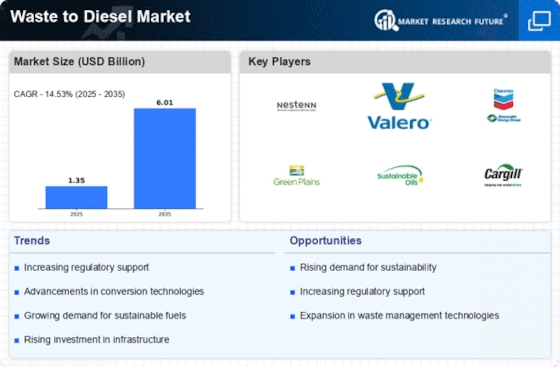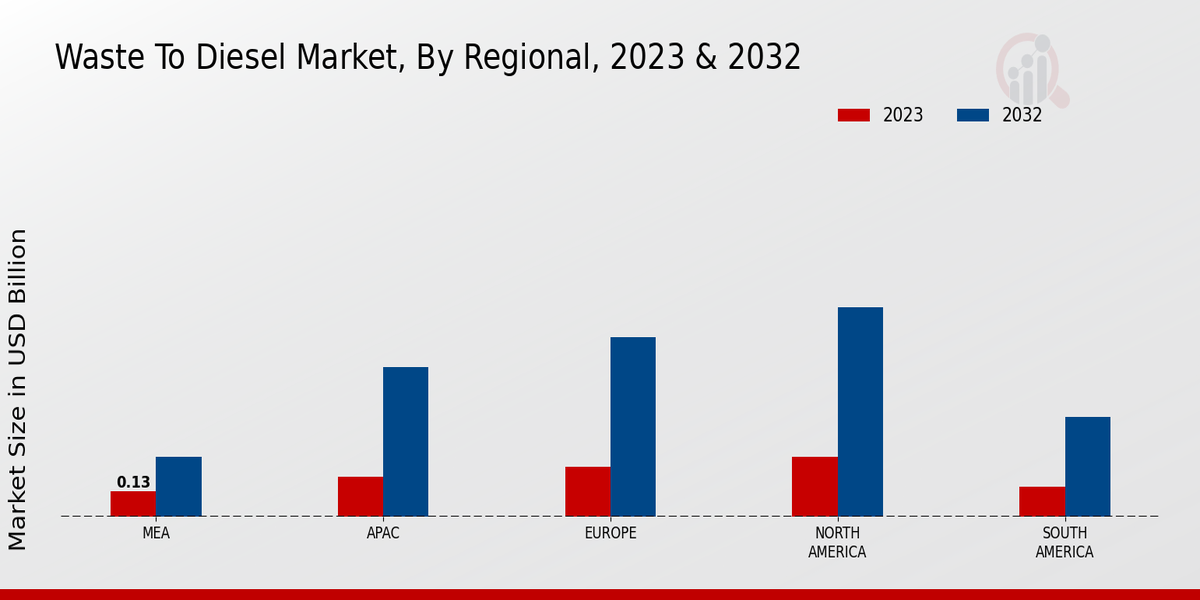Market Growth Projections
The Global Waste to Diesel Market Industry is projected to experience substantial growth, with forecasts indicating a market value of 1.35 USD Billion in 2024 and an impressive 6.01 USD Billion by 2035. This growth trajectory, characterized by a compound annual growth rate of 14.55% from 2025 to 2035, reflects the increasing adoption of waste-to-diesel technologies across various sectors. The market's expansion is driven by a combination of factors, including rising demand for sustainable fuels, technological advancements, and supportive government policies. These projections highlight the industry's potential to transform waste management practices and contribute to a more sustainable energy landscape.
Government Incentives and Support
Government incentives play a crucial role in propelling the Global Waste to Diesel Market Industry forward. Various nations are implementing policies that provide financial support for waste-to-energy projects, including tax breaks and grants. For instance, the United States has introduced programs aimed at promoting renewable fuel production, which encourages investment in waste-to-diesel technologies. Such initiatives are expected to bolster market growth, as they lower the financial barriers for companies entering the sector. The anticipated compound annual growth rate of 14.55% from 2025 to 2035 underscores the potential for expansion driven by supportive regulatory frameworks.
Rising Demand for Sustainable Fuels
The Global Waste to Diesel Market Industry experiences a surge in demand for sustainable fuels as governments and consumers increasingly prioritize environmental responsibility. This shift is driven by stringent regulations aimed at reducing greenhouse gas emissions and promoting renewable energy sources. For instance, the European Union has set ambitious targets for reducing carbon emissions, which has led to a growing interest in waste-to-diesel technologies. The market is projected to reach 1.35 USD Billion in 2024, reflecting the urgency for cleaner fuel alternatives. This trend suggests that the industry is likely to expand significantly as more stakeholders recognize the potential of waste-derived fuels.
Growing Awareness of Circular Economy Principles
The concept of a circular economy is gaining traction, influencing the Global Waste to Diesel Market Industry significantly. This paradigm shift emphasizes the importance of resource recovery and waste minimization, aligning with the goals of sustainability. Companies are increasingly adopting circular economy practices, which include converting waste into usable products like diesel. This trend is evident in regions such as Europe, where initiatives promote the recycling and repurposing of materials. As awareness of circular economy principles expands, the market is expected to benefit from increased investment and innovation, further solidifying its role in sustainable energy production.
Technological Advancements in Conversion Processes
Innovations in waste-to-diesel conversion technologies are pivotal in enhancing the efficiency and viability of the Global Waste to Diesel Market Industry. Advanced processes such as pyrolysis and gasification are being refined to maximize yield and minimize operational costs. For example, recent developments in catalytic processes have improved the quality of diesel produced from waste materials. These advancements not only increase the attractiveness of waste-to-diesel solutions but also contribute to the industry's projected growth, with an anticipated market value of 6.01 USD Billion by 2035. This indicates a robust trajectory for technological integration within the sector.
Increasing Waste Generation and Management Challenges
The escalating volume of waste generated globally presents both challenges and opportunities for the Global Waste to Diesel Market Industry. As urbanization continues to rise, municipalities face mounting pressure to manage waste effectively. This situation creates a pressing need for innovative waste management solutions, including the conversion of waste into diesel. Countries like India and Brazil are exploring waste-to-diesel technologies to address their waste crises while simultaneously producing valuable fuel. The growing recognition of waste as a resource rather than a burden is likely to drive market growth, as stakeholders seek sustainable solutions to waste management.



















Leave a Comment